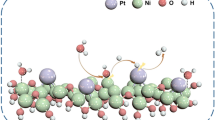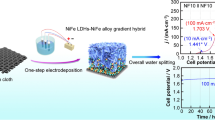Abstract
Electrochemical water splitting can produce hydrogen without harmful emissions. However, the need for more cheap and efficient catalysts presents a significant bottleneck for this technology. With a diverse chemical composition and electronic properties, transition metal dichalcogenides have been extensively investigated for catalysing hydrogen evolution reactions. Major approaches to enhance these materials’ activity are based on increasing active site counting and enhancing their intrinsic activity, which can be achieved by doping. In this work, we performed ab initio calculations to investigate the catalytic activity of pristine and Pt-doped 1 T-TiSe2. Our results show that basal plane transition metal sites are meta-stable for adsorption, while chalcogen sites are most favourable. Furthermore, catalytic activity was enhanced after the Pt introduction, as indicated by the change in the ∆G towards zero. Nonetheless, Pt sites exhibited the best activity among the investigated sites.
Graphical abstract




Similar content being viewed by others
Data availability
The datasets generated during and/or analysed during the current study are available from the corresponding author on reasonable request.
References
F. Safari, I. Dincer, Energy Convers. Manage. (2020). https://doi.org/10.1016/j.enconman.2019.112182
A.M. Oliveira, R.R. Beswick, Y. Yan, Curr. Opin. Chem. Eng. (2021). https://doi.org/10.1016/j.coche.2021.100701
IEA, The Future of Hydrogen, IEA, Paris (2019) https://www.iea.org/reports/the-future-of-hydrogen
P.J. Megía, A.J. Vizcaíno, J.A. Calles, A. Carrero, Energy Fuels (2021). https://doi.org/10.1021/acs.energyfuels.1c02501
S. Wang, A. Lu, C.J. Zhong, Nano Convergence (2021). https://doi.org/10.1186/s40580-021-00254-x
J. Zhu, L. Hu, P. Zhao, L.Y.S. Lee, K.Y. Wong, Chem. Rev. (2020). https://doi.org/10.1021/acs.chemrev.9b00248
C. Li, J.B. Baek, ACS Omega (2020). https://doi.org/10.1021/acsomega.9b03550
H.H. Huang, X. Fan, D.J. Singh, W.T. Zheng, Nanoscale (2020). https://doi.org/10.1039/C9NR08313H
J. Zhu, R. Yang, G. Zhang, Chem. Phys. Mater. (2022). https://doi.org/10.1016/j.chphma.2021.11.005
C. Tsai, K. Chan, J.K. Nørskov, F. Abild-Pedersen, Surf. Sci. (2020). https://doi.org/10.1016/j.susc.2015.01.019
Q. Tang, D. Jiang, ACS Catal. (2016). https://doi.org/10.1021/acscatal.6b01211
J. Deng, H. Li, J. Xiao, Y. Tu, D. Deng, H. Yang, H. Tian, J. Li, P. Ren, X. Bao, Energy Environ. Sci. (2015). https://doi.org/10.1039/C5EE00751H
F.J. Di Salvo, D.E. Moncton, J.V. Waszczak, Phys. Rev. B (1976). https://doi.org/10.1103/PhysRevB.14.4321
A.F. Kusmartseva, B. Sipos, H. Berger, L. Forró, E. Tutis, Phys. Rev. Lett. (2009). https://doi.org/10.1103/PhysRevLett.103.236401
D. Zhang, G. Zhao, P. Li, Y. Zhang, W. Qiu, J. Shu, Y. Jiang, S.X. Dou, W. Sun, Chem. A Eur. J. (2018). https://doi.org/10.1002/chem.201704661
T.R. Juran, M. Smeu, J. Power Sources (2019). https://doi.org/10.1016/j.jpowsour.2019.226813
M. Hellgren, L. Baguet, M. Calandra, F. Mauri, L. Wirtz, Phys. Rev. B (2021). https://doi.org/10.1103/PhysRevB.103.075101
P. Giannozzi et al., J. Phys.: Condens. Matter (2009). https://doi.org/10.1088/0953-8984/21/39/395502
P. Giannozzi et al., J. Phys. Condensed Matter (2017). https://doi.org/10.1088/1361-648X/aa8f79
G. Prandini et al., npj Comput. Mater. (2018). https://doi.org/10.1038/s41524-018-0127-2
K. Lejaeghere et al., Science (2016). https://doi.org/10.1126/science.aad3000
J.P. Perdew, K. Burke, M. Ernzerhof, Phys. Rev. Lett. (1996). https://doi.org/10.1103/PhysRevLett.77.3865
H.J. Monkhorst, J.D. Pack, J.D. Phys, Rev. B (1976). https://doi.org/10.1103/PhysRevB.13.5188
J.K. Nørskov, J. Rossmeisl, A. Logadottir, L. Lindqvist, J.R. Kitchin, T. Bligaard, H. Jónsson, J. Phys. Chem. B (2004). https://doi.org/10.1021/jp047349j
A. Lasia, Int. J. Hydrogen Energy (2019). https://doi.org/10.1016/j.ijhydene.2019.05.183
J. Ekspong, E. Gracia-Espino, T. Wagberg, J. Phys. Chem. C (2020). https://doi.org/10.1021/acs.jpcc.0c05243
J.K. Nørskov, T. Bligaard, A. Logadottir, J.R. Kitchin, J.G. Chen, S. Pandelov, U. Stimming, J. Electrochem. Soc. 10(1149/1), 1856988 (2005)
J.S. Chen, J.K. Wang, S.V. Carr, S.C. Vogel, O. Gourdon, P. Dai, E. Morosan, Phys. Rev. B (2015). https://doi.org/10.1103/PhysRevB.91.045125
Acknowledgments
The authors thanks CCM-UFABC for the computational resources provided and PRH.49 UFABC for the financial support and CNPq (#310045/2019-3).
Author information
Authors and Affiliations
Corresponding author
Ethics declarations
Conflict of interest
There are no conflict of interest.
Additional information
Publisher's Note
Springer Nature remains neutral with regard to jurisdictional claims in published maps and institutional affiliations.
Supplementary Information
Below is the link to the electronic supplementary material.
Rights and permissions
Springer Nature or its licensor (e.g. a society or other partner) holds exclusive rights to this article under a publishing agreement with the author(s) or other rightsholder(s); author self-archiving of the accepted manuscript version of this article is solely governed by the terms of such publishing agreement and applicable law.
About this article
Cite this article
Oliveira, C.C., Autreto, P.A. Optimized 2D nanostructures for catalysis of hydrogen evolution reactions. MRS Advances 8, 307–310 (2023). https://doi.org/10.1557/s43580-023-00549-7
Received:
Accepted:
Published:
Issue Date:
DOI: https://doi.org/10.1557/s43580-023-00549-7




